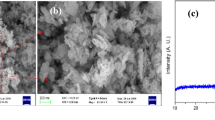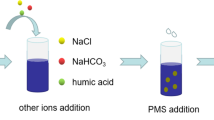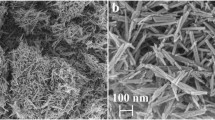Abstract
A one-step hydrothermal method for preparation of copper oxides with different valences using ascorbic acid as a reducing reagent was developed for environmental remediation. The results suggested that the notable degradation performance of CuO0 may be attributable to the abundant active sites, such as Cu or Cu–O, and was not significantly related to the Cu valence state. In contrast to direct degradation of pollutants by traditional superoxide radicals (O2•−), O2•− played an important role in the reduction of high-valence Cu ions (Cu(III)). In addition, a series of radical quenching, electron paramagnetic resonance (EPR), and electrochemical experiments validated the existence of direct electron transfer between methylene blue (MB) and PMS mediated by CuO0 and surface-bound radicals. The results suggested that the CuO0/PMS system may be less susceptible to diverse ions and natural organic matter other than dihydrogen phosphate anions. The mechanism of MB degradation under alkaline conditions was different from that under acidic conditions in that it was not reliant on radicals or charge transfer but direct oxidation by PMS. This study provides new insights into the heterogeneous processes involved in PMS activation by the copper oxides. Furthermore, this paper devotes to providing theoretical basis on pollutant removal via PMS activated by copper oxides and developing low-cost and high-efficiency catalysts.









Similar content being viewed by others
Data Availability
All data generated or analyzed during this study are included in this published article.
References
Biesinger M, Lau L, Gerson A, Smart R (2010) Resolving surface chemical states in XPS analysis of first row transition metals, oxides and hydroxides: Sc, Ti, V Cu and Zn. Appl Surf Sci 257:887
Bohme K, Brauer H (1992) Generation of singlet oxygen from hydrogen peroxide disproportionation catalyzed by molybdate ions. Inorg Chem 31:3468–3471
Buxton G, Greenstock C, Helman W, Ross A (1988) Critical review of rate constants for reactions of hydrated electrons, hydrogen atoms and hydroxyl radicals (.OH/.O-) in aqueous solution. J Phys Chem Ref Data 17(2):513–886
Cai S, Zhang Q, Wang Z, Hua S, Ding D, Cai T, Zhang R (2021) Pyrrolic N-rich biochar without exogenous nitrogen doping as a functional material for bisphenol A removal: performance and mechanism. Appl Catal B 291:120093
Cao H, Li X, Chen Y, Gong M, Wang J (2012) Effect of loading content of copper oxides on performance of Mn-Cu mixed oxide catalysts for catalytic combustion of benzene. J Rare Earths 30(9):871–877
Chen C, Liu L, Guo J, Zhou L, Lan Y (2019) Sulfur-doped copper-cobalt bimetallic oxides with abundant Cu(I): a novel peroxymonosulfate activator for chloramphenicol degradation. Chem Eng J 361:1304–1316
Chen C, Liu L, Li Y, Li W, Zhou L, Lan Y, Li Y (2020) Insight into heterogeneous catalytic degradation of sulfamethazine by peroxymonosulfate activated with CuCoO4 derived from bimetallic oxalate. Chem Eng J 384:123257
Chen H, Yang S, Chang J, Yu K, Li D, Sun C, Li A (2012) Efficient degradation of crystal violet in magnetic CuFe2O4 aqueous solution coupled with microwave radiation. Chemosphere 89:185–189
Chen T, Zhu Z, Zhang H, Qiu Y, Yin D (2021) Regulable metal-oxo-bridge configurations as electron transfer bridge to promote Cu(II)/Cu(I) redox behavior for efficient peroxymonosulfate activation. J Hazard Mater 410
Clifton C, Huie R (1989) Rate constants for hydrogen abstraction reactions of the sulfate radicals, SO4.- Alcohols. Int J Chem Kinet 21(8):677–687
Ding J, Nie H, Wang S, Chen Y, Wan Y, Wang J, Xiao H, Yue S, Ma J, Xie P (2021) Transformation of acetaminophen in solution containing both peroxymonosulfate and chlorine: performance, mechanism, and disinfection by-product formation. Water Res 189:116605
Dong G, Ai Z, Zhang L (2014) Total aerobic destruction of azo contaminants with nanoscale zero-valent copper at neutral pH: promotion effect of in-situ generated carbon center radicals. Water Res 66:22–30
Du X, Zhang Y, Hussain I, Huang S, Huang W (2017) Insight into reactive oxygen species in persulfate activation with copper oxide: activated persulfate and trace radicals. Chem Eng J 313:1023–1032
Duan X, Ao Z, Zhou L, Sun H, Wang G, Wang S (2016) Occurrence of radical and nonradical pathways from carbocatalyst for aqueous and nonaqueous catalytic oxidation. Appl Catal B 188:98–105
Fang L, Liu K, Li F, Zeng W, Hong Z, Xu L, Sh Q, Ma Y (2021) New insights into stoichiometric efficiency and synergistic mechanism of persulfate activation by zero-valent bimetal (iron/copper) for organic pollutant degradation. J Hazard Mater 403:123669
Feng Y, Liu J, Wu D, Zhou Z, Deng Y, Zhang T, Shih K (2015) Efficient degradation of sulfamethazine with CuCo2O4 spinel nanocatalysts for peroxymonosulfate activation. Chem Eng J 280:514–524
Ghanbari F, Moradi M (2017) Application of peroxymonosulfate and its activation methods for degradation of environmental organic pollutants: review. Chem Eng J 310:41–62
Hong R, Guo Z, Gao J, Gu C (2017) Rapid degradation of atrazine by hydroxyl radical induced from montmorillonite templated subnano-sized zero-valent copper. Chemosphere 180:335–342
Huang Y, Yu X, Gan H, Li J, Gong H (2021) Degradation and chlorination mechanism of fumaric acid based on SO4 center dot-: ant experimental and theoretical study. Environ Sci Pollut Res 28(35):48471–48480
Ji Y, Lu J, Wang L, Jiang M, Yang Y, Yang P, Zhou L, Ferronato C, Chovelon J (2018) Non-activated peroxymonosulfate oxidation of sulfonamide antibiotics in water: kinetics, mechanisms, and implications for water treatment. Water Res 147:82–90
Jiang C, Ji Y, Shi Y, Chen J, Cai T (2016) Sulfate radical-based oxidation of fluoroquinolone antibiotics: kinetics, mechanisms and effects of natural water matrices. Water Res 106:507–517
Khan A, Liao Z, Liu Y, Jawad A, Ifthikar J, Chen Z (2017) Synergistic degradation of phenols using peroxymonosulfate activated by CuO-Co3O4@MnO2 nanocatalyst. J Hazard Mater 329:262–271
Li H, Tian J, Xiao F, Huang R, Gao S, Cui F, Wang S, Duan X (2020a) Structure-dependent catalysis of cuprous oxides in peroxymonosulfate activation via nonradical pathway with a high oxidation capacity. J Hazard Mater 385:121518
Li H, Zhang P, Guo Y, Jia J, Wang S, Duan X, Cui F, Gao S, Tian J (2021) Iron-doped cuprous oxides toward accelerated nonradical oxidation: doping induced controlled facet transformation and optimized electronic structure. Chem Eng J 407:127172
Li W, Liu B, Wang Z, Wang K, Lan Y, Zhou L (2020b) Efficient activation of peroxydisulfate (PDS) by rice straw biochar modified by copper oxide (RSBC-CuO) for the degradation of phenacetin (PNT). Chem Eng J 395:125094
Li X, Jia Y, Zhou M, Su X, Sun J (2020c) High-efficiency degradation of organic pollutants with Fe, N co-doped biochar catalysts via persulfate activation. J Hazard Mater 397:122764
Liu J, Zhou J, Ding Z, Zhao Z, Xu X, Fang Z (2017) Ultrasound irritation enhanced heterogeneous activation of peroxymonosulfate with Fe3O4 for degradation of azo dye. Ultrason Sonochem 34:953–959
Liu Y, Miao W, Feng Y, Fang X, Li Q, Du N, Wang D, Mao S (2020) Enhanced peroxymonosulfate oxidation via Cu(III) species with a Cu-MOF-derived Cu nanoparticle and 3D graphene network. J Hazard Mater 403:123691
Neta P, Huie R, Ross A (1988) Rate constants of reactions of inorganic radicals in aqueous solution. J Phys Chem Ref Data 17:1027–1284
Norzaee S, Taghavi M, Djahed B, Mostafapour F (2018) Degradation of penicillin G by heat activated persulfate in aqueous solution. J Environ Manage 215:316–323
Oh W, Dong Z, Lim T (2016) Generation of sulfate radicals through heterogeneous catalysis for organic contaminants removal: current development, challenges and prospects. Appl Catal Environ 194:169–201
Pan Y, Zhang Y, Zhou M, Cai J, Tian Y (2019) Enhanced removal of emerging contaminants using persulfate activated by UV and pre-magnetized Fe0. Chem Eng J 361:908–918
Peng Q, Ding Y, Zhu L, Zhang G, Tang H (2018) Fast and complete degradation of norfloxacin by using Fe/Fe3C@NG as a bifunctional catalyst for activating peroxymonosulfate. Sep Purif Technol 202:307–317
Qi C, Liu X, Ma J, Lin C, Li X, Zhang H (2016) Activation of peroxymonosulfate by base: implications for the degradation of organic pollutants. Chemosphere 151:280–288
Qin Q, Qiao N, Liu Y, Wu X (2020) Spongelike porous CuO as an efficient peroxymonosulfate activator for degradation of Acid Orange 7. Appl Surf Sci 521:146479
Rao P, Hayon E (1975) Redox potentials of free radicals. IV. Superoxide and hydroperoxy radicals. O2- and.HO2. J Phys Chem 79:397–402
Shao P, Duan X, Xu J, Tian J, Shi W, Gao S, Xu M, Cui F, Wang S (2017) Heterogeneous activation of peroxymonosulfate by amorphous boron for degradation of bisphenol S. J Hazard Mater 322:532–539
Sun Y, Xie H, Zhou C, Wu Y, Pu M, Niu J (2021) The role of carbonate in sulfamethoxazole degradation by peroxymonosulfate without catalyst and the generation of carbonate radicals. J Hazard Mater 398:122827
Wang L, Xu H, Jiang N, Wang Z, Jiang J, Zhang T (2020a) Trace cupric species triggered decomposition of peroxymonosulfate and degradation of organic pollutants: Cu(III) being the primary and selective intermediate oxidant. Environ Sci Technol 54:4686–4694
Wang N, Ma W, Ren Z, Du Y, Xu P, Han X (2018) Prussian blue analogues derived porous nitrogen-doped carbon microspheres as high-performance metal-free peroxymonosulfate activators for non-radical-dominated degradation of organic pollutants 6(3):884-895
Wang S, Gao S, Tian J, Wang Q, Wang T, Hao X, Cui F (2020b) A stable and easily prepared copper oxide catalyst for degradation of organic pollutants by peroxymonosulfate activation. J Hazard Mater 387:121995
Wang Y, Tian D, Chu W, Li M, Lu X (2019) Nanoscaled magnetic CuFe2O4 as an activator of peroxymonosulfate for the degradation of antibiotics norfloxacin. Sep Purif Technol 212:536–544
Xian G, Niu L, Zhang G, Zhou N, Long Z, Zhi R (2020) An efficient CuO-γFe2O3 composite activates persulfate for organic pollutants removal: performance, advantages and mechanism. Chemosphere 242:125191
Xu H, Wang D, Ma J, Zhang T, Lu X, Chen Z (2018) A superior active and stable spinel sulfide for catalytic peroxymonosulfate oxidation of bisphenol S. Appl Catal B 238:557–567
Xu Y, Ai J, Zhang H (2016) The mechanism of degradation of bisphenol A using the magnetically separable CuFe2O4/peroxymonosulfate heterogeneous oxidation process. J Hazard Mater 309:87–96
Yang X, Ding X, Zhou L, Zhao Q, Ji Y, Wang X, Chovelon J, Xiu G (2021) Direct oxidation of antibiotic trimethoprim by unactivated peroxymonosulfate via a nonradical transformation mechanism. Chemosphere 263:128194
Yang Y, Banerjee G, Brudvig G, Kim J, Pignatello J (2018) Oxidation of organic compounds in water by unactivated peroxymonosulfate. Environ Sci Technol 52(10):5911–5919
Zhang T, Chen Y, Wang Y, Le Roux J, Yang Y, Croue J (2014) Efficient peroxydisulfate activation process not relying sulfate radicals generation for water pollutant degradation. Environ Sci Technol 48:5868–5875
Zhang T, Yang Y, Li X, Yu H, Wang N, Li H, Du P, Jiang Y, Fan X, Zhou Z (2020) Degradation of sulfamethazine by persulfate activated with nanosized zero-valent copper in combination with ultrasonic irradiation. Sep Purif Technol 239:116537
Zhang T, Zhu H, Croué J (2013) Production of sulfate radical from peroxymonosulfate induced by a magnetically separable CuFe2O4 spinel in water. Environ Sci Technol 47:2748–2791
Zhao Y, Song M, Cao Q, Sun P, Chen Y, Meng F (2020) The superoxide radicals’ production via persulfate activated with CuFe2O4@Biochar composites to promote the redox pairs cycling for efficient degradation of ο-nitrochlorobenzene in soil. J Hazard Mater 400:122887
Zhao Y, Wang H, Li X, Yuan X, Jiang L, Chen X (2021) Recovery of CuO/C catalyst from spent anode material in battery to activate peroxymonosulfate for refractory organic contaminants degradation. J Hazard Mater 420:126552
Zhong Q, Lin Q, Huang R, Fu H, Zhang X, Luo H, Xiao R (2020) Oxidative degradation of tetracycline using persulfate activated by N and Cu codoped biochar. Chem Eng J 380:122608
Zhou P, Zhang J, Zhang Y, Zhang G, Li W, Wei C, Liang J, Liu Y, Shu S (2018) Degradation of 2, 4-dichlorophenol by activating persulfate and peroxymonosulfate using micron or nanoscale zero-valent copper. J Hazard Mater 344:1209–1219
Zhou Y, Jiang J, Gao Y, Pang S, Yang Y, Ma J, Gu J, Li J, Wang Z, Wang L, Yuan L, Yang Y (2017) Activation of peroxymonosulfate by phenols: important role of quinone intermediates and involvement of singlet oxygen. Water Res 125:209–218
Zhou Z, Tian N, Li J, Broadwell I, Sun S (2011) Nanomaterials of high surface energy with exceptional properties in catalysis and energy storage. Chem Soc Rev 40:4167–4185
Zhu Z, Ji C, Zhong L, Liu S, Cui F, Sun H, Wang W (2017) Magnetic Fe-Co crystal doped hierarchical porous carbon fibers for removal of organic pollutants. J Mater Chem A 5:18071–18080
Zuo S, Li D, Yang F, Xu H, Huang M, Guan Z, Xia D (2021) Copper oxide/graphitic carbon nitride composite for bisphenol A degradation by boosted peroxymonosulfate activation: mechanism of Cu-O covalency governs. J Colloid Interface Sci 603:85–93
Zuo X, Nie J, Jiang B, Jiang A, Zou S, Wu J, Ding B, Wang X, Liu Y (2022) Direct degradation of methylene blue by unactivated peroxymonosulfate: reaction parameters, kinetics, and mechanism. Environ Sci Pollut Res. https://doi.org/10.1007/s11356-022-21197-8
Funding
This work was supported by National Military Standard Research Project of China (20CH0612) and Dazhangxing Project of Naval Medical Center of PLA (21M0601).
Author information
Authors and Affiliations
Contributions
Xu Zuo: Conceptualization, Investigation, Writing—original draft. Aijun Jiang: Methodology. Shiyang Zou: Editing & Supervision. Junrong Wu: Supervision. Bingquan Ding: Investigation.
Corresponding author
Ethics declarations
Consent to participate
The authors all agree to participate in the paper.
Consent for publication
The authors all agree that the paper is published in the journal.
Competing interests
The authors declare no competing interests.
Additional information
Responsible Editor: Ricardo A. Torres-Palma
Publisher's note
Springer Nature remains neutral with regard to jurisdictional claims in published maps and institutional affiliations.
Highlights
• Abundant active sites, such as Cu or Cu–O played a more important role in MB degradation rather than Cu valence.
• O2•− not degrading MB but involved in reduction of high valence Cu.
• Surface-bound radicals and charge transfer mediated by CuO0 was responsible for MB removal.
• Degradation of MB under alkaline was not reliant on radicals or charge transfer but direct oxidation by PMS.
Supplementary Information
Below is the link to the electronic supplementary material.
Rights and permissions
Springer Nature or its licensor holds exclusive rights to this article under a publishing agreement with the author(s) or other rightsholder(s); author self-archiving of the accepted manuscript version of this article is solely governed by the terms of such publishing agreement and applicable law.
About this article
Cite this article
Zuo, X., Jiang, A., Zou, S. et al. Copper oxides activate peroxymonosulfate for degradation of methylene blue via radical and nonradical pathways: surface structure and mechanism. Environ Sci Pollut Res 30, 13023–13038 (2023). https://doi.org/10.1007/s11356-022-23024-6
Received:
Accepted:
Published:
Issue Date:
DOI: https://doi.org/10.1007/s11356-022-23024-6




